For waging war, it is said, three things are required: money, more money and even more money. Much the same can be said about the preparation for war: apart from the financial burden involved in equipping armed forces, their training can come with a significant pricetag as well. Large-scale maneuvers in particular can be quite expensive – ammunition, rations and other consumables get expended, while equipment gets wet, dirty or even broken. As a result, political decision-makers often shy away from letting their soldiers run maneuvers, something unpopular with the latter group; the Prussian military theorist Carl von Decker noted in 1835 with more than a hint of frustration that, in eight years of command, he did not get the chance to fire one of his guns once.1
The 1800 invention of the topographic map made it possible, however, to transfer large-scale troop maneuvers onto a table, thereby offering officers at least some of the command experiences they could make on physical maneuvers.2 First introduced as a professional instrument in 1824 into the Prussian army, these “map-maneuvers” were called Kriegsspiele, a term from the late 18th Century onwards originally applied to offshoots of the game of chess.3 From the last third of the 19th Century onwards, their use became widespread among industrialized armies, both for training military decision makers and for planning military operations; the English translation of the German term – wargame – is nowadays commonly used even outside the Anglophone world for a wide variety of maneuver- or exercise-like simulations. As Peter Perla writes, wargames are “warfare model[s] or simulation[s] whose operation does not involve the activities of actual military forces, and whose sequence of events affects and is, in turn, affected by the decisions made by players representing the opposing sides.”4 Beyond their primary use as an educational tool for military decision makers, wargames can serve a variety of other purposes, including analyzing and understanding past and present conflicts.5
In using wargames in the classroom, it is often claimed that less is more. Simple wargames offer several key advantages over more involved, complex examples: they are easy to learn, require little in the way of preparation and have a limited running time. They therefore not only allow participants with limited previous experience to take a meaningful part in it, also make it possible to run several in succession, which in turn allows for some comparative analysis. Thus games that focus for example on the allocation of key resources like Philip Sabin’s Second World War6 offer the opportunity to analyze the effect of various different resource distribution patterns.7
All these advantages are obvious, as are large and complex wargames’ disadvantages: their rules are often rather involved and difficult-to-learn, the amount of preparation needed is considerable, and they tend to run for quite a long time, usually making it impossible to re-run them even only once. As a consequence, they are generally considered of being of little value for use in class, and one cannot but agree with Philip Sabin’s statement that “the great majority of published manual and computer wargames are, unfortunately, too complex, time consuming or unrealistic to be used directly in an academic context.”8
Our Use of Wargames
For several years now, we have employed both simple and complex wargames at Julius-Maximilians-Universität Würzburg for teaching both history and digital humanities students within their respective programs. Simple wargames include simplified versions of Philip Sabin’s Lost Battles (2007) system9 and Diekplous, a Würzburg-designed wargame depicting ancient naval warfare.10 In both cases, the simplicity of the rules made it possible to have both the actual wargame and a post-mortem discussion take place within the usual timeslot of 90 minutes, thereby creating a break in a course where the learning – and teaching – experience is otherwise dominated by the analysis of source material. More involved simulations included the simulation of the Roman emperor Claudius’ invasion of Britain in AD 43: here, one logistical planning exercise and three different wargames – a tactical wargame for the actual landing, an operational one covering follow-up operations and another tactical one for battles resulting from the second wargame – were connected with each other and formed the core of a course on the Claudian invasion of Britain.
On the whole, our experience indeed indicates that simple wargames are useful for various purposes. However, we believe that a case can also be made for employing complex wargames in class as well, particularly when they are used to demonstrate the difficulties military decision makers have to overcome when they face what since the early 19th Century is commonly called “friction”. In 1832, the German military theorist Carl von Clausewitz identified a general unpredictability due to the impact of chance events and an overall lack of precise information on anything outside an commander’s immediate field of view as one of the most important characteristics of war, in which according to Clausewitz “everything … is very simple but the simplest thing is difficult.”11 The result of this unpredictability is quite dramatic: “Countless minor incidents – the kind you can never really foresee – combine to lower the general level of performance, so that one always falls far short of the intended goal.”12 To Clausewitz, friction – best described as the series or sequence of events causing that unpredictability – was the key characteristic of military operations in times of war. However, military decision-makers were not helplessly exposed to it: “the good general must know friction in order to overcome it”, though Clausewitz added reflectively “whenever possible,”13 thereby emphasizing that friction was ever-present in times of war and never entirely avoidable.
While Clausewitz developed his theory of friction at the end of the Napoleonic period, its basic assumptions of the role of chance events and the lack of information hold true in the age of the drone and satellite as much as they did in the age of the horse and musket. Although military decision makers of the 21 Century have command, control, communications and intelligence capabilities beyond the wildest dreams of Napoleonic officers, the “fog of war” remains a key condition of any battlefield or combat situation: “we hardly know accurately our own situation at any particular moment, while the enemy’s, which is concealed from us, must be deduced from very little evidence.”14
Any in-depth analysis of military conflict therefore has to take the “fog-of-war” in particular and “friction” in general into account. However, our experience has shown getting students to fully comprehend the importance of these two factors is not easy. This paper describes the use of a fairly complex corps-level wargame in class and argues that, for specific purposes such as trying to convey to students the problems of “friction” and “fog of war” of a 19th Century battlefield, a complex simulation can actually be quite useful and is indeed practicable, even if it requires considerable preparation.
A “friction simulator” based on the Prussian Kriegsspiel.
As noted above, the complex interrelationship between the availability of crucial information, its reliability and the quality of its eventual processing – present on all levels of military and political decision-making and the impact “friction” can have on the outcome of any decision making process are not easy to grasp for modern students of the 21st Century. Additionally, students have been brought up in an environment where rapid technological progress appears to have made nearly unlimited access to information possible. In order to offer students at least some experience of friction – or rather, in order to simulate such an experience – we therefore regularly use a set of wargaming rules specifically developed for that purpose.
Pluie de Balles, named after a famous quotation of Ferdinand Foch on the nature of late 19th/early 20th century infantry combat according to which the infantryman had to face a rain of bullets on the battlefield,15 is essentially an analog army corps level wargame depicting conflict on a late 19th Century battlefield. On each side, participants take on one of two roles: either they – usually in teams of at least two or three – command forces on the battlefield of brigade or division size, depending on the scenario, or they become part of the overall army corps HQ trying to coordinate different forces on a large and complex battlefield.
Pluie de Balles has been in use at Julius-Maximilians-Universität since 2013 , and a large corps-level wargame running over several hours takes place twice a year. The wargame forms part of an interdisciplinary course open to students of both our history and digital humanities programs, introducing wargaming to the former as an educational and analytical tool while serving for the latter as a general introduction to the design and use of conflict simulations.
In designing the wargame, we decided to focus on a topic that is comparatively easy to understand for most students, and on game mechanisms that do not pose great challenges for the participants. Prior experience in other courses with wargames covering ancient or medieval conflicts had shown that pre-modern conflict in general is more difficult for students without a deeper knowledge of the period to relate to; depicting 20th or even 21st Century conflict on the other hand is not without its practical difficulties, given the multidimensionality of the modern battlefield. We therefore chose the second half of the 19th Century, an age when industrialization and technological progress had already dramatically transformed warfare on land and at sea but had as yet to add more dimensions to it.16
The main principle guiding the development of the ruleset was accessibility: in order to make rules easily accessible to the participants a purely analog simulation was chosen, making it possible to discuss the impact of rules design on the outcome of the simulation, something not as easily possible with a computer-based simulation.17 Running an analog simulation also limits the logistical requirement to a set of rooms, dice and various pieces of printed paper and cardboard. The basic mechanisms were kept as simple as possible to allow students with little or no prior wargaming experience to participate after a limited amount of instruction. Throughout the past few years, the rules have seen incremental improvements as the result of both post-mortem discussions among teaching staff and student participation in the form of term papers, BA theses, and so forth.
Apart from serving as a general introduction to wargaming, the main purpose of Pluie de Balles is twofold: Its main purpose as a “friction simulator” is to give students a very general idea of how decisions in war are invariably influenced by imperfect communication, which can result in information that is insufficient, outdated, wrong – or simply not there at all. In addition, Pluie de Balles also serves well to explain the complex interrelationship between force size, space, communications, and command and control, which is of key importance for understanding conflict in the late 19th and early 20th Century. Previous teaching experience had shown that particularly the latter issue of command and control was rather difficult for students to engage with in a purely theoretical manner.
In focusing on communication as well as command and control and force-space related issues, Pluie de Balles shares many elements with the Prussian “Kriegsspiel”, the world’s first professional wargame which was first introduced in the Prussian army in 1824 and throughout the following decades consequently updated according to the tactical and technological developments of the time.18
In fact, as far as its general setup is concerned, Pluie de Balles is essentially a “gamified” version of the Prussian “Kriegsspiel”. The latter relies quite heavily on intensive umpiring, as the actual participants control their forces exclusively by writing orders, receiving dispatches and trying to create their own picture of the situation on the battlefield according to the information they get. Throughout the 19th Century, the Kriegsspiel was often played on a single map, particularly when only a small number of participants were involved. Both surviving rulesets and contemporary descriptions show however that, in the case of larger scenarios, participants were supposed to be physically separated from each other either by curtains or by being placed in separate rooms. Ideally, the umpires would in such a case occupy yet another room, something actually specified in some of the rulesets.19 In such a case, only the map used by the umpires represents the – simulated – “reality” on the battlefield, whereas the maps of the participants serve mainly to visualize how they think that reality might be, based on the information they have at hand (or rather based on how they interpret the information they have at hand).
The Prussian “Kriegsspiel” is mainly an exercise in military decision-making on a tactical and operational level, aimed at training officers in directing forces of up to army corps strength on the battlefield; after the mid-1870s, it was expanded in scope to the direction of whole campaigns and the interaction of armies composed of several army corps. The Prussian “Kriegsspiel” emphasizes communication and information procressing, while the simulation of the actual conflict other hand – i.e., movement and combat, which is usually at the core of modern wargaming rules used for recreational purposes – is mostly confined to the umpires. They have to process the orders sent by the participants, move units and then resolve conflicts according to the rules, which are primarily meant to be aids for the umpires; participants are not required to have any deeper knowledge of the rules. Also, the umpires are responsible for writing dispatches which simulate the upstream of information from subordinate officers back to the participants, who then have to make decisions based on that information. The primary task of the participants therefore is to constantly update their own map with regard to the positions of both their own forces and those of the enemy.
As a result of its setup, the “Kriegsspiel” simulates quite well the effects of friction caused by fog of war and by imperfect communication in particular; depending on how diligent the participants process the information available to them, comparing their maps to that of the umpires can show significant differences.20 Furthermore, the handling of almost all rules by the umpires allows for the use of complex and detailed mechanisms for combat resolution without distracting the participants from what they are supposed to concentrate on: decision-making. There is, however, a significant downside to relying on umpires, as we have experienced in several test games both with students and with actual military decision makers: the success of a “Kriegsspiel” depends heavily on the umpiring team.
Large scenarios beyond divisional level usually require an umpiring team of significant size, a ratio of at least one umpire per every two participants being advisable. Moreover, the combination of the workload associated with a large scenario and an inexperienced umpiring team can slow the “Kriegsspiel” down considerably, causing longer periods of time during which there is very little to do for the participants. This may to some extent simulate the actual dynamics of military action; in a “Kriegsspiel” test with German army officers,21 one of the participants remarked that the experience was “quite similar to reality – most of the time nothing happens, but if something happens, it does so too fast.” However, such an experience is unlikely to keep the attention of university students over an extended period of time.
Therefore the Prussian “Kriegsspiel” itself has only limited potential for classroom use. In designing Pluie de Balles, our main aim was to keep the focus of the “Kriegsspiel” on demonstrating the role of friction in military decision making, while at the same time largely eliminating the need for umpires. This results in a key difference between the “Kriegsspiel” and Pluie de Balles: while the former separates the participants from each other and has the umpires resolve all combat, in the latter this is done by the participants themselves.
We decided to include this element originating with commercial wargames – and alien to the general setup of the Prussian “Kriegsspiel” as it keeps the participants from focusing exclusively on information processing and decision making – for three reasons: First of all, involving the participants in moving and fighting their units significantly reduces the number of umpires required for running the game; indeed, if all participants have a good knowledge of the rules and are capable of reading the topographic map on which Pluie de Balles is played (see below), there is no need for umpires.
Second, the involvement of the participants in movement and combat adds a “gamistic” element that significantly increases student commitment; experience has shown that even students with no prior experience of any type of conflict games can engage quickly with Pluie de Balles once they have a basic understanding of the rules, and for on average about two-thirds of a class the wargame will cause sufficient immersion to have an impact on their social interaction with their fellow students. Getting students to engage with and – if possible – even immerse into the simulation is one key factor determining whether running the wargame is successful or not; if students were unwilling to actively take part in Pluie de Balles, it would invariably fail – and do so on quite a scale, given the size of it. However, our experience of running Pluie de Balles over more than five years has been entirely positive – if anything, umpires had to step in several times to limit the effects of immersion on the participants.
The third reason for involving the participants in movement and combat – and for setting and enforcing rigid time limits of two minutes for each turn (see below) – is the “fog of war” which in Pluie de Balles is by design initially confined to participants forming the corps HQs. These are physically separate from their subordinate force commanders who work in separate rooms on maps each covering only parts of the overall battlefield; as a consequence, corps HQs have a complete map depicting all of the battlefield but get only the information their subordinates are able – or willing – to pass on to them, resulting in considerable “friction.” Participants actually moving and fighting units do so on maps where both friendly and enemy units are visible all the time, eliminating in theory any element of fog of war.
In practice, our experience has shown that, due to a strict enforcing of rigid time limits, participants not only tend to focus on their own units at the expense of overall situational awareness, the time limits also often keep them from passing crucial information on towards their corps HQ. This can create situations where an outside observer might easily notice a glaringly obvious opening for a decisive move – of which the force commanders are blissfully unaware due to their total focus on their own units. In fact, cavalry units quite often manage to create considerable havoc behind enemy lines, striking at divisional HQs and lines of communication, even though their approach is always for everybody there to see, and cries of “Where did that cavalry come from?!” are a common feature in Pluie de Balles. The strict limitation of turns to two minutes thus serves to at least partly offset the lack of a mechanism depicting fog of war.
One consequence of this difference between Pluie de Balles and the Prussian “Kriegsspiel” is that, whereas in the Prussian “Kriegsspiel” the participants do not need to have any deeper knowledge of the rules, in Pluie de Balles such a knowledge is a key requirement for the force commanders, as they cover everything relevant for moving and fighting units – as opposed to members of the corps HQs, who are free to organise themselves as they deem to be sufficient; there are only two limitation imposed on participants acting as overall HQ: they may not enter the rooms in which their force commanders are present, and the only means of communication allowed is a written order.
Pluie de Balles
As noted above, Pluie de Balles is an corps-level wargame and would thus in theory allow for the employment of a fairly large-scale map and individual units not smaller than a battalion or even a brigade – for comparison, the basic building block of the Prussian “Kriegsspiel”, infantry battalions, artillery batteries and cavalry squadrons for a 1:6000 map, makes it possible to cover for example the Königgrätz battlefield on two A0 sized map sheets. However, with the aim of causing friction in mind, Pluie de Balles was deliberately designed to overwhelm the participants with regard both to the scale of the map and to the number of gaming elements involved. Pluie de Balles is played on a 1:2500 topographic map, with scenarios often calling for maps of 2 x 3 m or even 2 x 4 m size (see fig. 1). The standard infantry token has a size of 15 x 30 mm and depicts a formation of up to 100 infantrymen, usually a company; a similar-sized token is used for units of around 30 cavalrymen. Smaller units – half companies, smaller teams of specialists, individual guns, limbers, ammunition wagons – are depicted by smaller token of 15x15mm size.
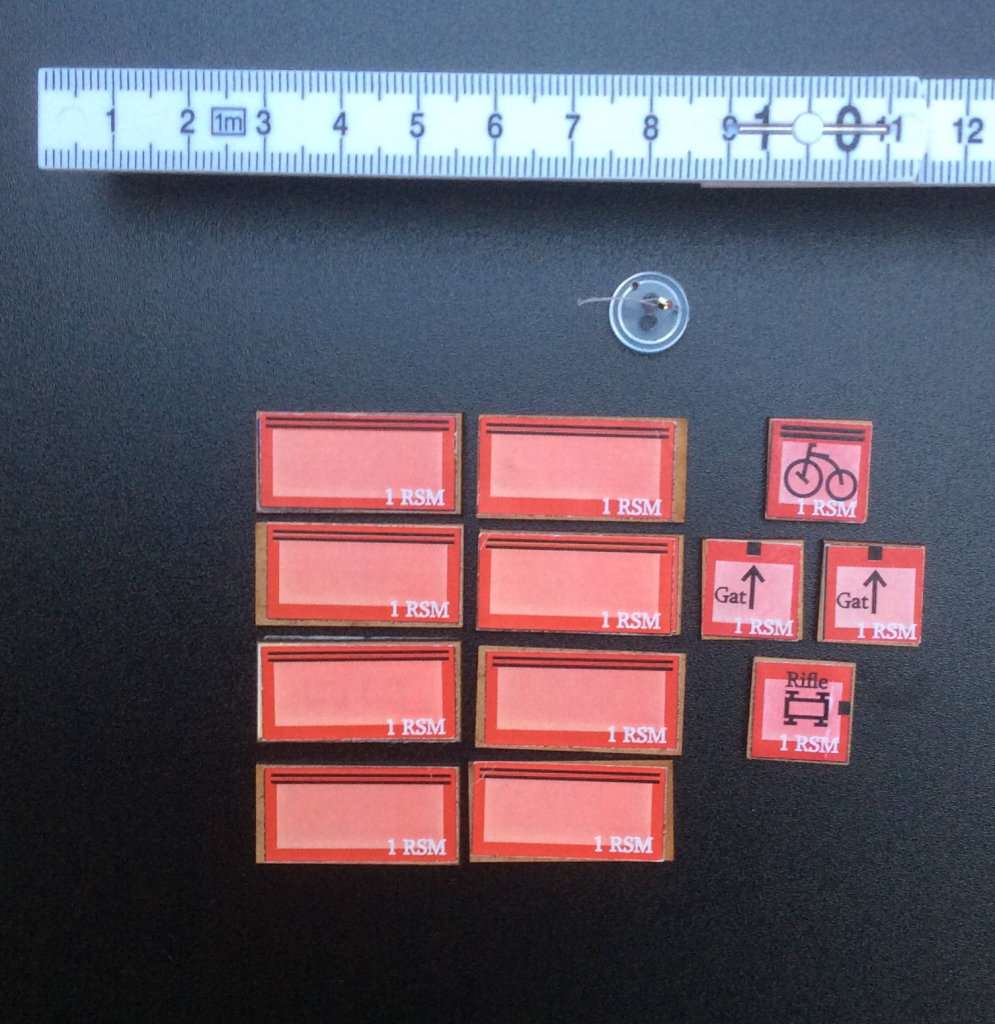
As a consequence, force commanders regularly have more than only a handful of tokens to move around – to give just one example, a typical French division of the Franco-Prussian War with two brigades totalling 13 battalions of infantry and two batteries of foot artillery would be represented by 128 tokens, with 13 additional tokens for the ammunition supply and typically five to seven tokens for divisional command and communications personnel, for a total of around 150 tokens (see fig. 2). In addition to the tokens, markers are required for battalion, brigade and divisional commanders, for which small flags are used – in the case of the French division this adds another 18 flags to the material required for representing a division on the map. Depending on the scenario, games can thus involve well over 1000 tokens, flags and markers in all.
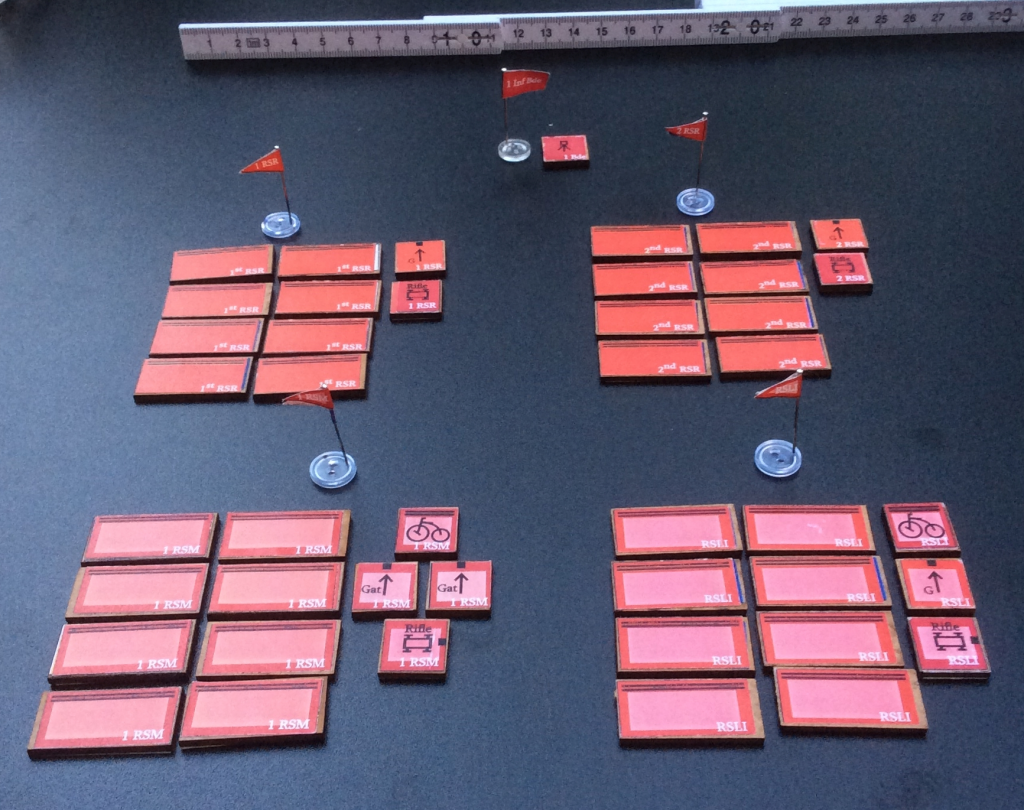
Experience has shown that the task of staying in control of this mass of gaming equipment alone – and doing so within the confines of a turn of two minutes – is not without its challenges, to put it mildly, even if command of a division-sized formation is given to teams of two or three participants. Over time, trying to retain control over large formations while at the same time communicating with Corps HQ will cause significant friction , both in a “Clausewitzian” sense as intended by the game designers and at times on a social level between the participants as well – usually, every other game the umpires are asked by one or both Corps HQ teams whether they have the authority to replace some of their subordinate commanders.
While the sheer size of the game and the comparatively short turns thus result in a heavy workload for the participants in Pluie de Balles – which only increases after units have begun to engage each other – it offers one practical advantage: even large numbers of students can easily be accommodated in Pluie de Balles, and scenarios with around 40 participants have been run very successfully, with all sides usually claiming to be short on manpower after an hour or two into the game.
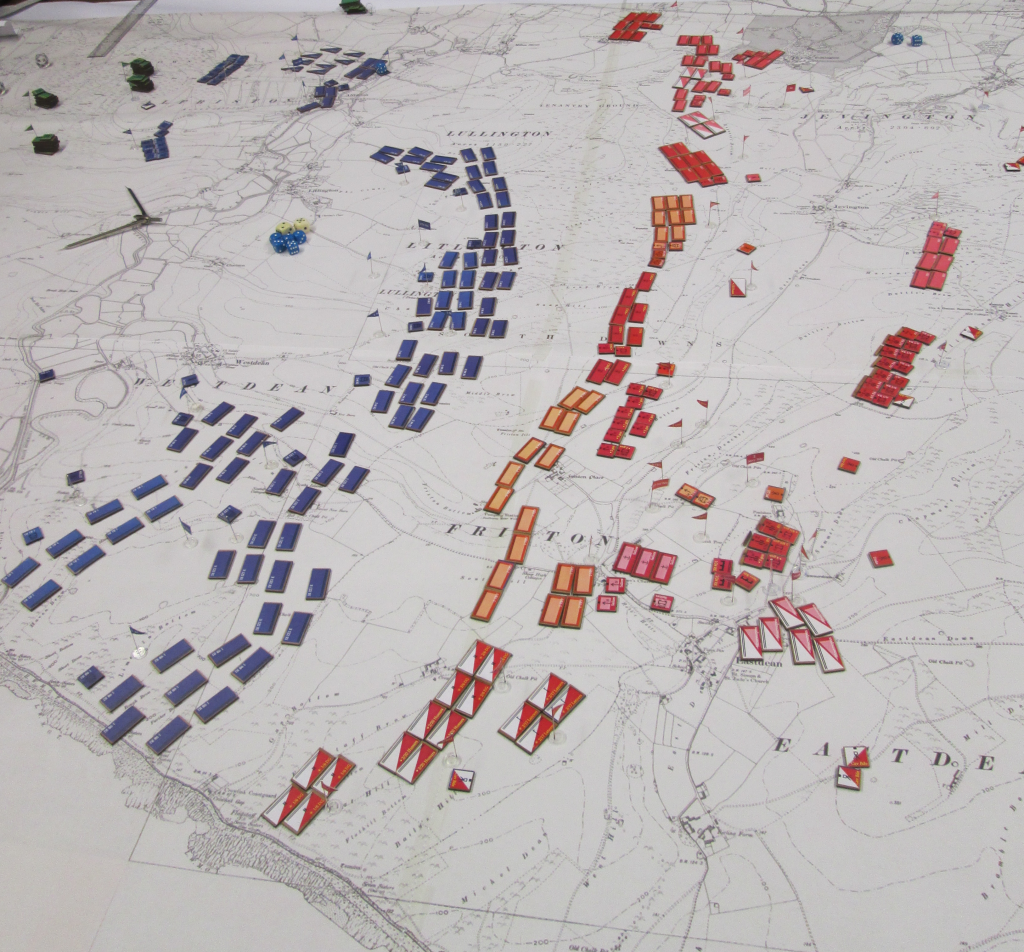
The scale of both map and gaming material, while visually the most obvious aspect of Pluie de Balles, is however only of secondary importance. Rather, it is the depiction of command, control and communications, – and particularly the chaos insufficient communications can produce – which is the main raison d’etre of Pluie de Balles. As a consequence, both movement and combat resolution mechanism are highly simplified and built around a simple throw of dice: in order to move one of his units, a field commander has to throw the number of D6 corresponding to the movement class of the unit,22 the result being the maximum range of his unit in the turn. In order to fight an enemy unit a D20 is thrown and the result compared to the data table entry for the weapon system in use; successes, i.e., results equal or greater than the value in the data table, result in hits. Experience has shown that the movement and combat mechanisms are easy to master even by students without any prior wargaming experience.
Of somewhat greater complexity is the core mechanism of Pluie de Balles – unit activation. Before a unit can move or enter combat, it has to be activated first, normally by throwing 1D20 against a basic activation value of 5. While this partly reflects the problem of subordinates not always carrying out orders as intended – they may not get the order in the first place, misunderstand it, decide to deliberately ignore it, or they may simply lie face down in their tent in a puddle of port – the main purpose of the mechanism is to force field commanders to care about unit cohesion. Thus losing contact with brigade or divisional commanders carries heavy activation penalties – for example, a battalion completely on its own could gain a total of up to 12 to its activation value. In Pluie de Balles, it is assumed that direct communication is only possible within a predefined range. As a consequence, participants are strongly advised to keep their assets fairly close together. Communication over longer distances is possible as well, either along telegraph lines or by using heliographs; long range communication is often vital for maintaining contact with divisional and corps level HQs which are usually located well to the rear of the front line.
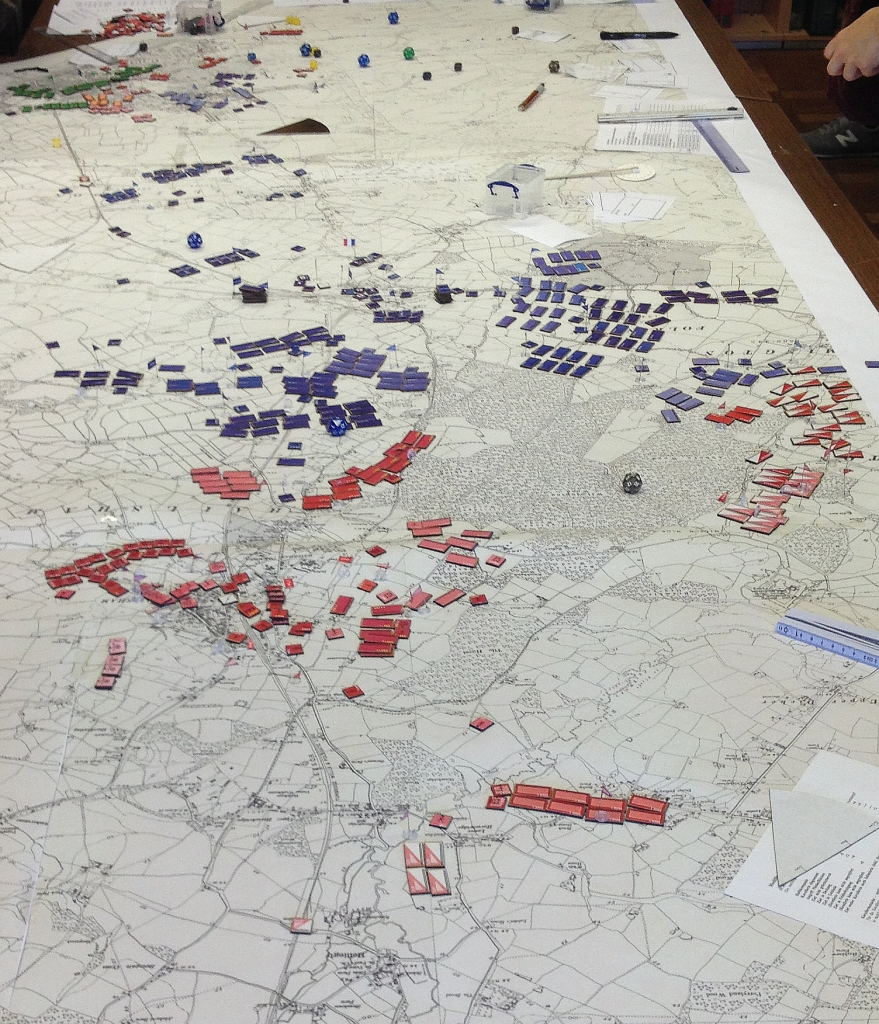
Breaking up formations in order to use their elements independently from each other is therefore extremely difficult in Pluie de Balles, reflecting the reality of the latter half of the 19th Century, when the battalion, usually represented by eight tokens and a small flag, still was the smallest unit on the battlefield, with company tactics only slowly emerging during the very last decades of the century. The activation mechanism thus prevents participants from using anachronistic or even ahistorical battlefield tactics. Furthermore, a rudimentary mechanism has been added to enforce the care for supplies – both infantry battalions and artillery pieces have ammunition supply attached to them, the loss of which results in penalties during a firefight.
By themselves, the mechanisms mentioned above are not overly complex, and experience has shown that students have little difficulties in getting acquainted with the movement and combat mechanism. The main difficulty, particularly when moving units for greater distances, is keeping up lines of communication from each battalion to its brigade HQ and from each brigade HQ to its divisional HQ; success or failure in a game of Pluie de Balles often directly depends on how well – or badly – the lines of communication are organized and protected.
Implementation
While Pluie de Balles can be used for any mid to late 19th century conflict, we usually use scenarios taken from British late-19th century invasion novel literature,23 featuring either French or Russian armies descending on the coasts of Great Britain. For that purpose, topographic maps from the Ordnance Survey 6in series – enlarged to a scale of 1/2500 – are used. To ensure the importance of Corps HQ level decisions on the overall outcome, all scenarios feature at least two areas of combat that are physically separate from each other, e.g., two sides of a river, a range of hills or two areas east and west of a major city. These areas are then depicted on separate maps in separate rooms, and the scenario is designed so as to ensure that the outcome of the fighting in one area will influence the outcome in the other. In such a setup, corps HQ is able to exert crucial influence on the overall outcome of the battle by allocating reserves in order to exploit – or plug – gaps not apparent to the force commanders.
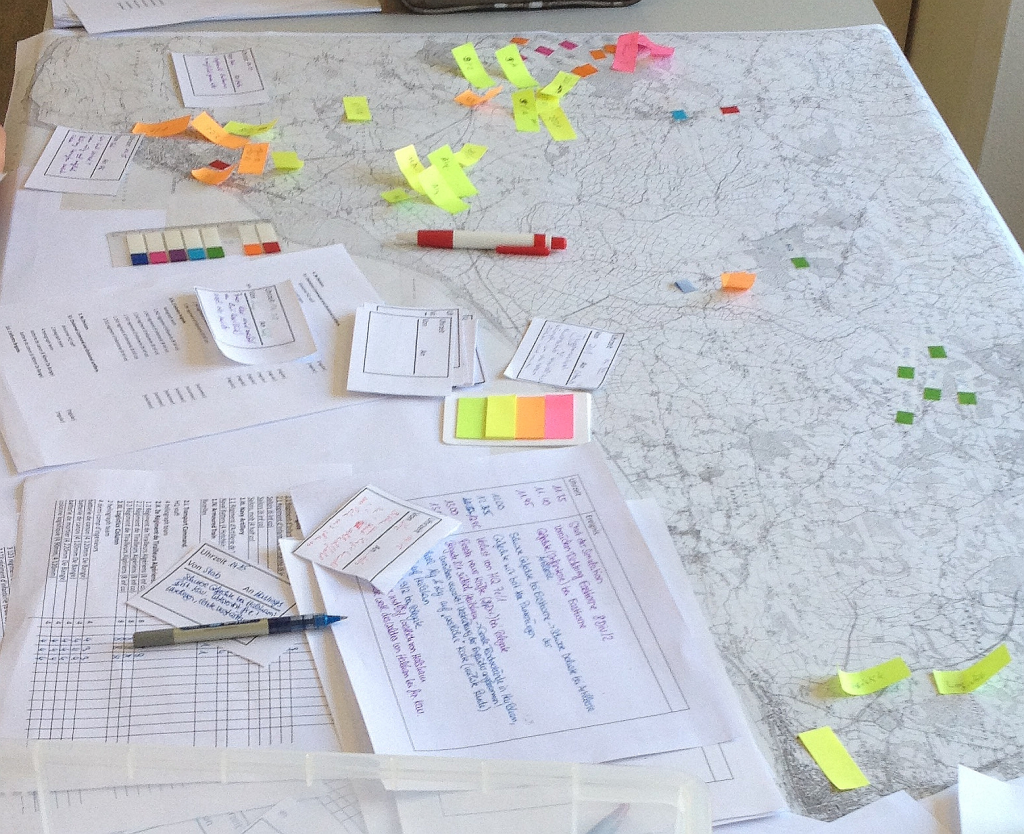
For use in class, the whole simulation extends over three phases, of which the actual wargame is just one. The first, preparatory phase is made up of three important elements: One, students have to get acquainted with the general political as well as military situation into which the actual scenario is set; for Pluie de Balles this includes an introduction into both the political history of the period spanning 1870/71 to 1900 and the literary history of that era with a particular focus on the development of invasion novel literature in Britain. Second, students have to prepare themselves for the specific scenario, for which they are provided with an information pack including a brief background to the fictional scenario, an order of battle of their own units, intelligence – often of questionable value – on the enemy, the actual mission and a large-scale map of the battlefield. In preparing for the wargame students have to diligently read the map as well as thoroughly study the actual mission and the composition of the forces involved. And finally, students have to be trained in the rules up to a point that confidence in the use of the rules makes player policing possible, with the umpire only necessary for enforcing the time limit for each turn and for rules clarification. At the same time, during the training of the rules the mechanics are open for discussions and adjustments can be made if necessary.
The actual running of the wargame is the second phase of the overall simulation. Usually, a minimum of four rooms is necessary for running Pluie de Balles:24 Field commanders should operate on at least two different maps in two different rooms, while blue and red HQs occupy rooms for themselves as well. Over the past years, Pluie de Balles usually ran over six to seven hours with on average around 25 participants; in order to have a corps HQ on both sides, a minimum of 12 participants is required, although scenarios with even smaller numbers of participants – for example eliminating the staff team on one side – are perfectly possible. Experience has shown that, while concentration among the participants tends to drop after around five to seven hours with exhaustion setting in, the wargame usually generates sufficient immersion even for students with limited or no prior experience in simulative gaming to actively engage with it.
The third phase, which is the shortest yet from an educational point of view probably the most important one, covers the final post-mortem, which ideally takes place as soon as possible after the end of the wargame. It is led by the umpiring team, which first identifies how key events developed and how they influenced the overall outcome. The discussion should focus on both the HQ teams’ and the force commanders’ decisions and their results both with regard to the sequence of events and to the eventual outcome including a discussion of the losses incurred. In doing so it is necessary to discuss how much the overall outcome was influenced by communications; in particular, the degree to which communications were actually functioning should be scrutinized. Also, cases where the rules caused a certain turn of action, which a different rule might have not led to, require closer attention as well. Experience has shown that even after a long wargame of seven hours students usually are still sufficiently committed for an in-depth discussion of their actions.
Conclusion.
Although it is a compromise between the realism of the original Prussian ”Kriegsspiel”’s various incarnations and the requirements of classroom use, Pluie de Balles has proven itself to be a successful tool for educating students about the role of friction in 19th Century land warfare. Moreover, it has been well received among students and raised considerable interest among them for problems of friction and information flow, and the nature of military conflict prior to WWI in general. Although the preparations required for running a large-scale wargame are considerable, it works rather well in helping students understand the issue of “friction” and in giving them a general introduction into what wargames are good for. Therefore, while we do still agree with the notion that smaller, less complex wargames are usually better suited for use in class, we would like to encourage our readers to experiment with large-scale wargames once in a while – if prepared properly, they can certainly be worth the effort.
—
Featured Image “Schloss Charlottenburg — Taktisches Kriegsspiel” by Jeroen Van Nieuwenhove @Flickr CC-BYNC
—
PD Dr Jorit Wintjes studied Classics and History and currently works as a Senior Lecturer in the History Department at
Julius-Maximilians-Universität Würzburg, teaching in both the
university’s History and Digital Humanities programs. He has published on ancient and 19th century military history; his current research interests include Roman naval history as well as the history of professional wargaming.
Dr Steffen Pielström studied Biology and currently works as a
Coordinator for the European research infrastructure project DARIAH at Julius-Maximilians-Universität Würzburg, teaching in the university’s Digital Humanities program. He has published on sociobiology and quantitative text analysis; his current research interests include stylometry and 19th century professional wargaming.

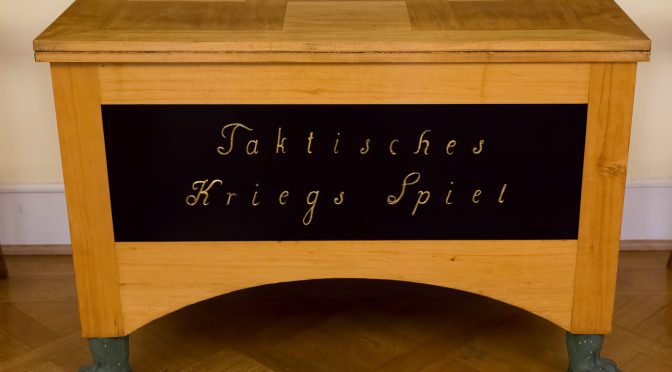
How can someone obtain a copy of the rules and supporting documents for Pluie de Balles?